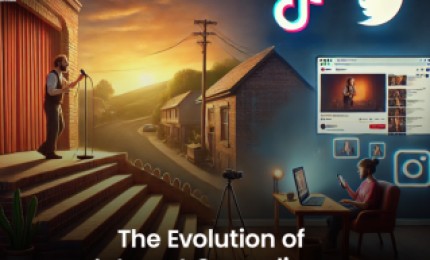In today's digital age, the influence of visual storytelling, particularly through video, has grown immensely. Video has risen to become the most dominant and captivating medium for communication. It merges the power of visuals, sound, and motion to convey messages and engage audiences in ways no other medium can match. Understanding the fundamentals of video creation is your gateway to harnessing this influential tool for your purposes.
The impact of video in our daily lives is undeniable. It has become the linchpin of our online experiences, from social media platforms to educational content, marketing campaigns, and entertainment. Its dynamic nature draws viewers in, holds their attention, and allows for a more profound connection with the content. Whether you're an aspiring content creator, a business looking to expand its digital footprint, or an individual eager to share your stories, mastering the basics of video creation is an invaluable skill.
Before you hit the record button, it's essential to crystalize your objectives. What's the primary aim of your video content? Are you seeking to entertain, educate, inspire, inform, or promote a product or service? Clarifying your purpose provides a guiding light for your content creation journey. It helps you maintain focus, ensuring that every element of your video aligns with your overarching goals.
Understanding your audience is paramount. Who are your intended viewers? What are their preferences, interests, demographics, and online behaviors? This audience insight informs your content decisions. Tailoring your content to match your viewers' tastes and expectations not only boosts engagement but also establishes a more genuine and lasting connection.
Video offers a plethora of styles to choose from, each with its unique appeal and purpose. Whether you opt for vlogs, tutorials, reviews, interviews, storytelling, animation, or live streams, your style should align with your content goals and resonate with your target audience. Each style has its unique storytelling potential, enabling you to convey your message effectively.
At the heart of every outstanding video is a compelling story. Even the most informative or promotional videos benefit from a well-structured narrative. A story with a clear beginning, middle, and end captivates viewers. Whether you're sharing a personal experience, explaining a complex concept, or showcasing a product, storytelling draws viewers in and leaves a lasting impression. The ability to tell a compelling story is the foundation of effective video communication.
Scriptwriting serves as the backbone of your video. It's where your ideas take shape and your message finds its voice. Begin by planning your content, outlining key messages, and crafting a script that's concise, engaging, and closely aligned with your purpose. If you're appearing on camera, rehearse your lines to ensure confident and natural delivery.
Storyboarding is particularly valuable for more complex videos. It allows you to visualize your shots, plan camera angles, and plot transitions. Think of it as a visual roadmap that ensures consistency and coherence in your video's narrative. A well-constructed storyboard keeps your production on track, saving time and resources during shooting.
The choice of location or set design significantly influences your video's aesthetics and message. Carefully select settings that complement your content and narrative. Pay close attention to lighting conditions, backgrounds, and props that enhance the storytelling experience. A thoughtfully designed environment elevates the overall quality of your video.
While you don't need top-of-the-line equipment to get started, investing in decent gear is essential for ensuring the quality of your production. Consider acquiring a good camera, microphone, and lighting equipment. These elements collectively contribute to clear visuals, crisp audio, and an overall professional look and feel. Remember that quality equipment enhances the viewer's experience and perception of your content.
Mastering camera basics is fundamental for creating visually appealing videos. Learn about framing, composition, camera angles, and movements. Each of these elements plays a crucial role in shaping how your audience perceives your content. Experiment with different techniques to discover your unique visual style. Effective framing ensures that your shots are aesthetically pleasing and that your message is conveyed effectively.
Audio quality is as crucial as video quality. Even if your visuals are stunning, poor audio can significantly detract from the impact of your content. Investing in a good microphone is essential for ensuring that your viewers can hear your message clearly. Reducing background noise and maintaining clear, crisp sound should be top priorities during production. High-quality audio enhances the overall viewing experience, allowing your audience to engage fully with your content.
Lighting is a critical element that shapes the mood and quality of your video. Whether you're shooting indoors or outdoors, understanding lighting fundamentals is essential. Natural light offers warmth and authenticity, while artificial lighting provides precise control over the lighting environment. Learning to manipulate light to achieve the desired look and feel for your video is a skill that sets professionals apart. Proper lighting elevates the quality of your production and ensures that your subject is well-lit and visually appealing.
During the production phase, take your time to capture the best possible shots. Recording multiple takes of each scene provides you with the flexibility to choose the most compelling footage during editing. Focus on maintaining consistency in your shots, from framing and composition to lighting and camera movements. A well-executed production phase is your opportunity to bring your creative vision to life with precision and attention to detail. Careful planning and execution ensure that your raw footage provides a solid foundation for the editing process.
Selecting the right video editing software is a critical decision in the post-production phase. Your choice should align with your skill level and the complexity of your projects. User-friendly options like iMovie and Adobe Premiere Rush are excellent choices for beginners, offering essential editing tools and intuitive interfaces. If you're seeking more advanced features and capabilities, Adobe Premiere Pro, Final Cut Pro, and DaVinci Resolve are industry-standard choices. Learning to navigate and utilize your chosen software effectively is crucial for bringing your creative vision to life during editing.
Editing is where your raw footage transforms into a polished video. It's where you assemble your shots, trim unnecessary content, add transitions, overlays, and effects, and refine your storytelling. Effective editing enhances the flow and impact of your video, ensuring that your message is conveyed succinctly and engagingly. It's also where you can experiment with pacing, rhythm, and visual style to create a captivating viewing experience. Editing is where your video truly comes alive and takes its final form.
Music and sound effects are potent tools for enhancing the emotional impact of your video. They add layers of depth and immersion to your storytelling. When selecting music, consider its tone, tempo, and how well it complements your narrative. The right soundtrack can evoke emotions, establish atmosphere, and underscore key moments in your video. Sound effects, on the other hand, enhance the viewer's sense of immersion, making the experience more vivid and engaging. Whether you're using royalty-free music or creating your own soundscapes, pay close attention to audio quality and synchronization during the editing process. Well-chosen audio elements can elevate your video from good to great.
Color correction and grading are post-production techniques that allow you to fine-tune the visual aesthetics of your video. Through these processes, you can adjust color balance, contrast, saturation, brightness, and more to achieve the desired look and feel. Color is a powerful storytelling tool that can convey mood, atmosphere, and emotion. By manipulating color, you can enhance the visual impact of your video and create a cohesive and engaging viewing experience. Experiment with different color grading techniques to find the style that best complements your content and narrative.
Once your video is polished and ready for the world to see, it's time to choose the right platforms for distribution. Popular platforms include YouTube, Vimeo, social media channels like Facebook, Instagram, and Twitter, as well as your own website or blog. The choice of platforms should align with your content and target audience. Each platform has its unique features and audience demographics. When uploading your video, pay careful attention to optimizing your titles, descriptions, and tags for search engine optimization (SEO). This step increases the discoverability of your video, helping you reach a broader audience.
Engagement is a vital component of your video creation journey. Interacting with your audience creates a sense of community around your content, fostering viewer loyalty and ongoing interaction. Respond to comments, messages, and social media interactions promptly and thoughtfully. Consider hosting live chats during video premieres to connect with your audience in real time. Building relationships with your viewers encourages them to become more active and engaged members of your community.
Measuring the performance of your videos is essential for understanding their impact and refining your content strategy. Video platforms offer built-in analytics tools that provide insights into your audience's behavior, including metrics like views, watch time, audience demographics, and engagement rates. Pay close attention to these metrics to identify trends and patterns. Additionally, listen to viewer feedback, comments, and messages. Viewer input can provide valuable insights into your audience's preferences and expectations. Use this data to adapt and refine your content strategy, ensuring that your future videos continue to resonate with your viewers.
Embarking on your video creation journey is a thrilling adventure filled with opportunities for creativity and self-expression. Whether you're producing content for personal fulfillment, educational purposes, or with specific goals in mind, the world of video offers a captivating medium to share your stories, knowledge, and experiences.
In this comprehensive beginner's guide to video creation, you've explored the foundational aspects of producing compelling video content. From defining your purpose and audience to crafting engaging stories, planning your production, and refining your editing skills, you now have the knowledge to create impactful videos that resonate with your viewers.

15 Ways to Make Money as a Singer: A Complete Guide to Monetizing Your VoiceEarning money as a singer requires more than just talent, it demands creativity, persistence, and a willingness to explore...
Read Blog
When Kunal Kamra's Humor Got Him Into Trouble: A Deep Dive into the Controversies of India's Most Fearless ComedianKunal Kamra Controversy: Laughter, Lawsuits, and the Limits of Free SpeechStand-up...
Read Blog
The Oscar race is always full of drama, but this year? It’s absolute chaos. From shocking controversies to unexpected winners, the battle for Best Picture at the 2024 Academy Awards has taken...
Read Blog
In the ever-changing landscape of entertainment, few transformations have been as dramatic and swift as the rise of internet comedians. What began as a platform for amateur funny videos has evolved...
Read Blog
Introduction: In the competitive world of entertainment and talent, having the right representation can make all the difference in launching and sustaining a successful career. Whether you're...
Read Blog.jpg)
While the world of modelling often dazzles with glitz and glam, it's also critical we discuss its darker shades, pulling the curtain back on some challenging realities. Today, let's embark on...
Read Blog